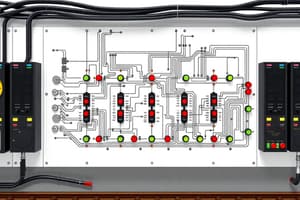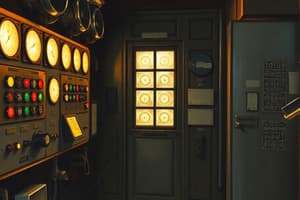Podcast
Questions and Answers
What is required to unblock a function in the emergency operations process?
What is required to unblock a function in the emergency operations process?
- Automatic approval from the system
- No special requirement
- Manual operation from the Control Panel
- SM's key (correct)
How long must the time delay be before all functions are un-blocked by the 'All Un Block' option during E.I start-up?
How long must the time delay be before all functions are un-blocked by the 'All Un Block' option during E.I start-up?
- 60 seconds
- 30 seconds
- 90 seconds
- 120 seconds (correct)
What must be done to operate points when the interlocking is free?
What must be done to operate points when the interlocking is free?
- Complete a system checklist
- Check the weather conditions
- Ensure all track circuits are clear (correct)
- Obtain a special key from the control room
What indicator shows that the E.I system is healthy?
What indicator shows that the E.I system is healthy?
What type of counters should be used while operating the Control Panel or Control Terminal?
What type of counters should be used while operating the Control Panel or Control Terminal?
Which feature indicates blocking of a function on the Control Terminal?
Which feature indicates blocking of a function on the Control Terminal?
What allows the switching of controls from one Control Terminal to another?
What allows the switching of controls from one Control Terminal to another?
What is a requirement for operating points when the point zone track circuit fails?
What is a requirement for operating points when the point zone track circuit fails?
What is the purpose of the latch relay in point control circuits?
What is the purpose of the latch relay in point control circuits?
Which feature prevents operation when the point is mid stroke?
Which feature prevents operation when the point is mid stroke?
What should the interface between the Control Panel and the Electronic Interlocking system be?
What should the interface between the Control Panel and the Electronic Interlocking system be?
How can Electronic Interlocking Systems be monitored?
How can Electronic Interlocking Systems be monitored?
What is required for the interface with external data logging equipment?
What is required for the interface with external data logging equipment?
What logic requirements apply to the Electronic Interlocking system?
What logic requirements apply to the Electronic Interlocking system?
How can the application logic for interlocking be modified?
How can the application logic for interlocking be modified?
What feature should be provided for the control of signals and points?
What feature should be provided for the control of signals and points?
What is required for the application logic used in the Electronic Interlocking system?
What is required for the application logic used in the Electronic Interlocking system?
What type of cabinets should be used for the installation of Electronic Interlocking systems?
What type of cabinets should be used for the installation of Electronic Interlocking systems?
What is a requirement for the Electronic Interlocking System concerning its safety integrity?
What is a requirement for the Electronic Interlocking System concerning its safety integrity?
What is the recommended practice for the installation of input and output cables in the Electronic Interlocking system?
What is the recommended practice for the installation of input and output cables in the Electronic Interlocking system?
Which of the following is NOT a condition that the Electronic Interlocking System must fulfill?
Which of the following is NOT a condition that the Electronic Interlocking System must fulfill?
What dimension quality is required for Control Terminal displays in Electronic Interlocking installations?
What dimension quality is required for Control Terminal displays in Electronic Interlocking installations?
Where should the Electronic Interlocking system ideally be installed in relation to the Operator Room?
Where should the Electronic Interlocking system ideally be installed in relation to the Operator Room?
What additional wiring practice is recommended for future alterations in the Electronic Interlocking system?
What additional wiring practice is recommended for future alterations in the Electronic Interlocking system?
Which of the following is a method through which operation of signals and points is performed in Electronic Interlocking?
Which of the following is a method through which operation of signals and points is performed in Electronic Interlocking?
What protection facility is required for Control Terminals against unauthorized operation?
What protection facility is required for Control Terminals against unauthorized operation?
Which statement is true regarding the installation of Control Panels in future Electronic Interlocking systems?
Which statement is true regarding the installation of Control Panels in future Electronic Interlocking systems?
What type of interlocking arrangements must be in accordance with the approved Signal Interlocking plan?
What type of interlocking arrangements must be in accordance with the approved Signal Interlocking plan?
What is the installation type required for the Electronic Interlocking System?
What is the installation type required for the Electronic Interlocking System?
What should the Electronic Interlocking system do when an internal failure occurs?
What should the Electronic Interlocking system do when an internal failure occurs?
What is the minimum delay before releasing operations after powering up the Electronic Interlocking system?
What is the minimum delay before releasing operations after powering up the Electronic Interlocking system?
Which configuration types can the Electronic Interlocking system be of?
Which configuration types can the Electronic Interlocking system be of?
What must be maintained as a part of completion circuit diagrams?
What must be maintained as a part of completion circuit diagrams?
How often should the version number and checksum change for the Application logic?
How often should the version number and checksum change for the Application logic?
What arrangement should the Electronic Interlocking system include to handle failures?
What arrangement should the Electronic Interlocking system include to handle failures?
What aspect must be synchronized in any configuration of the Electronic Interlocking system?
What aspect must be synchronized in any configuration of the Electronic Interlocking system?
Who approves the version control of the Electronic Interlocking system's software?
Who approves the version control of the Electronic Interlocking system's software?
Flashcards
EI System Approval
EI System Approval
The Electronic Interlocking (EI) system must be an approved type and meet the latest approved specifications.
EI Safety Integrity
EI Safety Integrity
The EI system must have the highest possible safety standards defined in the specifications.
EI Route Setting
EI Route Setting
The EI system's installation involves route setting through a dropdown menu or entry/exit control. Individual point operation is also supported.
Yard Signalling and Interlocking
Yard Signalling and Interlocking
Signup and view all the flashcards
EI Control Panel Usage
EI Control Panel Usage
Signup and view all the flashcards
Control Terminal Size
Control Terminal Size
Signup and view all the flashcards
Control Terminal Indications
Control Terminal Indications
Signup and view all the flashcards
EI Redundancy
EI Redundancy
Signup and view all the flashcards
Emergency Operations
Emergency Operations
Signup and view all the flashcards
Non-resettable Counters
Non-resettable Counters
Signup and view all the flashcards
Control Terminal Features
Control Terminal Features
Signup and view all the flashcards
Control Terminal Unblocking Delay
Control Terminal Unblocking Delay
Signup and view all the flashcards
Function Blocking Indication
Function Blocking Indication
Signup and view all the flashcards
Control System Switchover
Control System Switchover
Signup and view all the flashcards
System Health Indication
System Health Indication
Signup and view all the flashcards
Point Operation Restrictions
Point Operation Restrictions
Signup and view all the flashcards
Point Control
Point Control
Signup and view all the flashcards
Point Position Latch
Point Position Latch
Signup and view all the flashcards
Mid-Stroke Reversal
Mid-Stroke Reversal
Signup and view all the flashcards
Embedded Block Indication
Embedded Block Indication
Signup and view all the flashcards
Interlocking System Interface Types
Interlocking System Interface Types
Signup and view all the flashcards
Centralized/Distributed Control
Centralized/Distributed Control
Signup and view all the flashcards
E.I. Network Capabilities
E.I. Network Capabilities
Signup and view all the flashcards
Application Logic Modification
Application Logic Modification
Signup and view all the flashcards
EI System Installation
EI System Installation
Signup and view all the flashcards
EI Application Logic Verification
EI Application Logic Verification
Signup and view all the flashcards
EI System Protection
EI System Protection
Signup and view all the flashcards
EI Room Design
EI Room Design
Signup and view all the flashcards
EI System Wiring for Reliability
EI System Wiring for Reliability
Signup and view all the flashcards
EI Power-Up State
EI Power-Up State
Signup and view all the flashcards
EI Hot Standby
EI Hot Standby
Signup and view all the flashcards
EI Distributed Configuration
EI Distributed Configuration
Signup and view all the flashcards
EI System Software Version Control
EI System Software Version Control
Signup and view all the flashcards
EI Application Logic Version Control
EI Application Logic Version Control
Signup and view all the flashcards
EI Checksum Record
EI Checksum Record
Signup and view all the flashcards
EI Software Modification
EI Software Modification
Signup and view all the flashcards
EI System Time Synchronization
EI System Time Synchronization
Signup and view all the flashcards
Study Notes
Electronic Interlocking (El) Essential Requirements
- Electronic Interlocking systems must conform to the latest approved specifications and have the highest safety integrity.
- Systems must be suitable for both electrified and non-electrified sections.
- Installation must be route setting type using dropdown menus or entry/exit controls for point operations.
- Yard signaling and interlocking must align with approved plans and control tables.
- Systems must be compatible with control panels or terminals.
- Built-in redundancy is required per approved specifications.
Control Terminal (Video Display Unit (VDU))
- Existing control panels (if provided) for Electronic Interlocking installations follow requirements of Para 21.1.1 and 21.1.2.
- New installations should not use control panels, but use control terminals.
- Terminals should display the yard layout in a clear, well-proportioned format.
- All functions should be clearly distinguishable on the display.
- Multi-terminal setups are recommended for redundancy.
- Video display indicators should match control panel indicators as per Para 21.1.4 or other approved types.
- Controls like gates, cranks, siding and slots must be operated via drop-down menus.
- Terminals must have protection against unauthorized operation via a separate 'SM Key'.
Emergency Operations
- All emergency operations require a two-step process to prevent unintended actions.
- Only non-resettable counters are allowed when using control panels or terminals.
- Terminals must include provisions equivalent to a control panel's signal, point, and line block collars.
- A dedicated 'all unblock' feature is recommended for use during E.I start-up. This will un-block all lines/signals/points after 120 seconds.
Function Indication & System Health
- Clear indications (using colour codes or different markings) are required for all functions on Control Terminals and Panels where they are present.
- System health is indicated by a blinking green LED or similar indicator on the console.
- Switchover between control panels and terminals (or multiple terminals) can be manual or password-protected.
- Point operation needs interlocking to be free and relevant point track circuits clear. Emergency operation procedures include site verification before operation if point track circuits fail and a non-resettable counter for each such operation.
Electronic Interlocking Interface
- Electronic Interlocking system interfaces must follow approved specifications and should allow for distributed or centralised control.
- Interface with external data logging equipment is required.
- Systems are capable of being monitored/controlled from either a centralized or distributed location.
- Systems should be networkable for diagnostic and centralized control and monitoring purposes.
- Interlocking application logic must adhere to existing relay interlocking standards.
- Systems must be capable of modification when yard layouts change.
- Wiring diagrams and standards can be found in a supplementary document.
Powering Up Electronic Interlocking
- When powering up, the system must drive all necessary signals.
- In the event of internal failure, the system will signal the most restricted aspects.
- Upon startup, all signals and operations must be blocked.
- This block must be removed after verification of all safety functions and delay of at least 120 seconds.
Configuration of Electronic Interlocking
- Hot standby arrangements are required, ensuring no interruptions to signalling.
- Systems can either be centralised or distributed, with redundancy in OFC communication media.
- The system must synchronize time.
Software and Hardware Version Control
- System software and hardware versions need approval and control.
- Versions and checksums of application logic should be unique to each system and approved.
- Modifications will require updated checksums.
Installation and Testing
- Installation should comply with approved guidelines and advisory notes.
- Functionality and safety of the system's application logic must be verified through tests conducted by authorized personnel.
- Only approved application logic (with checksums) should be used in the system.
- The system should be housed in dustproof cabinets with transparent doors.
- Interfaces should be paralleled for improved reliability.
- Wiring and cables must be routed to minimize electromagnetic interference.
- The system should be placed near the operator room.
- The installation area should be easy to maintain.
Studying That Suits You
Use AI to generate personalized quizzes and flashcards to suit your learning preferences.
Related Documents
Description
Test your knowledge on the essential requirements for Electronic Interlocking systems and their control terminals. This quiz covers safety standards, installation protocols, and the functionalities of Video Display Units in the context of Electronic Interlocking. Ensure your understanding aligns with the latest approved specifications.




